A new interest with genealogy has arrived with DNA discoveries. The surge of testing has many following the procedure of determining the results and linking the evidence. Many queries arriving at Piedmont Trails are filled with requests to link themselves to a person of the early 18th century or earlier. For many, the reality of this specific task becomes very confusing as they begin to tread into unknown territories. On a personal note, my interest with genealogy has been with me much longer than the discovery of DNA. In fact, over thirty years of research has equipped me with a huge amount of resources. This experience has allowed me to locate the actual paper trail of my ancestors and has filled my journey with so many details and treasures. It’s this particular paper trail that will provide the proof from you to your newly discovered DNA relatives. Without this proof, you will not be able to link the desired DNA results to you or any other members of your family tree. It’s important to understand this first before you begin searching randomly through vast amounts of records.
Piedmont Trails will be introducing my personal techniques for genealogy researching entitled, “Footstep Tracking” on the Family Pages website next month. This unique method containing genealogy research techniques, has proven successful for me personally, time and time again. Before, I release the details and step by step instructions for Footstep Tracking, I want to share with you all, the 10 most important things you should know about each and every ancestor associated with your family tree. Without the knowledge of these 10 important details, your tree will have gaps and may mislead you to research in areas and locations that are unnecessary. For this segment, we will be focusing on the ancestors from the 18th and 19th centuries, namely 1700s and 1800s. Let’s begin with number 1 on the list.

#1-NAME
Number 1 is knowing the name of your ancestor. Every ancestor was born with a name given to them. This name is recorded time and time again on legal documents all during their lifespan. Make sure you have the legal name that was originally given to your ancestor. You will need to pinpoint and distinguish between nicknames, alias names and imposters. The legal name should be the name shown on your family tree. Other names that may have been used are details associated with their lives. Make no mistake, our ancestors often used various names, even on legal documents. I will explain more about this on the Footstep Tracking method arriving next month.
#2 & #3-BIRTH & DEATH DATE
Birth and Death dates are essential to your research. These dates enable you to create a timeline for your ancestor. Without a timeline, you will spend much of your research time searching useless records that have nothing to do with your ancestor at all. Steps 1 through 3 are your vital statistics and I suggest you have these facts prior to adding any other details about your ancestor on your personal family tree. I say this due to this very important reason; you may mistakenly add the wrong data and this data may lead you in the wrong direction to locate more records and documents.
#4-MARRIAGE
Marriage dates and details not only provide proof of the lineage continuing through to their children, but it allows the researcher to gain insights on the details of the person’s life. For example, where did the marriage ceremony take place? What kind of ceremony was it? Who were in attendance? Several of my ancestors married many times throughout their lives and they had children outside of their marriages as well. Marriage certificates and licenses are legal documents that prove your ancestor’s existence at a particular point within their timeline.
#5-GEOGRAPHICAL LOCATION
In order to fully research your ancestor, you must determine the geographical location of his/her existence at any particular time. Land deeds/grants and census records are just a few sources that can distinguish this location for you. Once the location has been proven, documents can be retrieved from the immediate area. Sorting through local records are an amazing journey. In order to perform this task efficiently, you must understand what records are available and the location of these specific documents. As I’ve said many times, “Location, Location, Location! It is the key to successfully removing those brick walls.”

#6 & #7-BURIAL & RELIGION
The location and details of the burial are extremely important to your research as well. You may find that your early ancestor from 1735 does not have a specific burial plot. This is true with many families living during this time period. However; burials from the 18th and 19th centuries were greatly influenced by the person’s own personal religion. Churches have been documenting records since their existence and so much of this data is waiting on you to discover. Once you’ve determined the faith of your ancestor, you gain the knowledge of possible locations where faith was practiced. Then, the pattern begins with sorting through local church records and finding the burial location if available. Religious documents are a source of huge amounts of genealogy material.
#8-MILITARY SERVICES
Ancestors from the 18th and 19th centuries are most likely to have served in a military action of some kind. These records can be found both locally and nationally. It is vital in knowing these facts in order to fully understand the details of your ancestor and the family unit. I mention the family unit due to the fact that any military action performed by a family member did indeed affect the entire household in many ways. During the time frame of this period, you have The French Indian War, The American Revolutionary War, The War of 1812, The Mexican War, The Civil War and The Spanish American War. You also have the Indian Wars from the onset of arrival in America up through the 19th century. Some sort of military action is greater than 75% for all families of this time period. Subscriptions or fees are not required to gain knowledge of this information. I will have more about the techniques that I personally use on Footstep Tracking.
#9-OCCUPATION
It is just as important to know what your ancestor did to support their family. This will lead to other documents such as trading or selling of merchandise, performing works as a blacksmith or farmer or conducting business as an attorney or tax collector. Also, be aware that women of this time period performed a variety of jobs as well. Don’t overlook your female ancestors when it comes to occupation research. Children as well performed duties that supported the family. Once you begin to learn of this, you will be amazed at your findings. Regardless of the occupation, knowing this information will enable you to conduct a more detailed search and discover more facts about your ancestor.
#10-MIGRATION ROUTES
90% of families from the 18th and 19th centuries migrated to another area. This location may have been less than 10 miles from the original location or it may have been thousands of miles away. The fact remains that this era witnessed daily migrations from one place to another from 90% of the time period population. Knowing these migration routes are essential to your research. It will enable you to learn of stops along the way that your ancestor may have made. It will also enable you to learn the condition of the route during that time period and how popular the route was. I personally view these early migration patterns as the “latest thing”. In other words, the general public today views the new mobile phone as the greatest thing. So, the majority buys the new cell phone. This is how our ancestors viewed the adventure from one place to another. It was popular and the “latest thing”. Studying neighbor’s actions as well as your ancestor’s actions will reveal many details and clues on their travels.

Take a moment to glance at your personal family tree. Do you have these 10 important facts for each of your ancestors from the 18th and 19th centuries? Many modern day hobby genealogists think that all of this data can be quickly accessible by online searching or by subscribing and paying fees to an online genealogy company. This simply is not true. Less than 20% of genealogy records can be found online. Regardless if you have a paid subscription or not. Personally, I’ve never subscribed to any genealogy company and why? There is simply no need to do so. Also, many online records are not accurate due to transcribing errors, etc. If you have any questions or comments about researching your family genealogy, post them here at the article or contact Piedmont Trails at the website link. I am so excited to bring you my personal techniques with “Footstep Tracking” next month. Stay tuned for the launching date. As always, Piedmont Trails wishes to Thank each of you for your support. The websites have grown so much during the past year. It is amazing to see all of the followers and we Thank You all so much!!
Everyone experiences discouragement with their genealogy research, but don’t allow this frustration to overwhelm you. I currently have so many projects going on, that I often take breaks from my personal research. When I do return, I often find new direction with small hints and clues that I may have overlooked before. The main thing to remember is to have fun with your research and Enjoy Your Journey !!
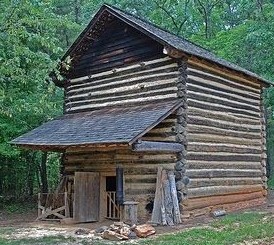
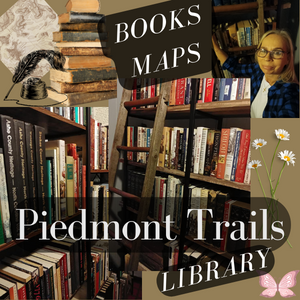


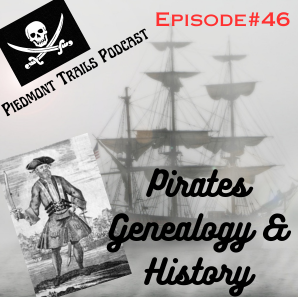
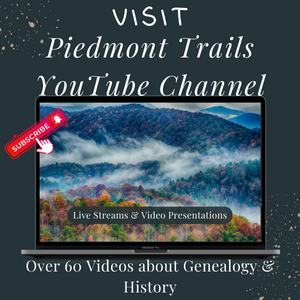


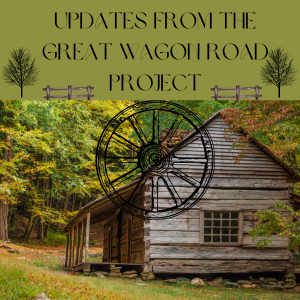

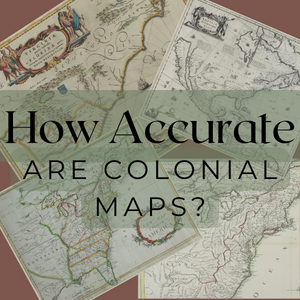
Thank you!!!
LikeLiked by 1 person